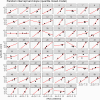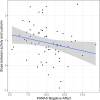Relationship Between Activity Level and Knee Function Is Influenced by Negative Affect in Patients Undergoing Cell Therapy for Articular Cartilage Defects in the Knee
- PMID: 36846815
- PMCID: PMC9950618
- DOI: 10.1177/23259671231151925
Relationship Between Activity Level and Knee Function Is Influenced by Negative Affect in Patients Undergoing Cell Therapy for Articular Cartilage Defects in the Knee
Abstract
Background: Increased activity level is generally reported to be positively related to improved knee function after knee surgery. However, little research has been conducted into this relationship on an individual patient basis, or the influence of demographic and psychosocial factors such as patient affect-the subjective experience of emotion.
Hypothesis: The relationship between postoperative activity level and knee function will vary between patients and will be influenced by the patients' affect and demographic characteristics.
Study design: Cohort study; Level of evidence, 3.
Methods: Activity, knee function, demographic, and affect data were collected from patients enrolled in an ongoing trial for the treatment of articular cartilage lesions at preoperative and 2-, 12-, and 15-month postoperative points. Quantile mixed regression modeling was used to determine the patient-to-patient variation in activity level and knee function. Multiple linear regression and partial correlation analyses were performed to determine whether demographic characteristics and patient affect were associated with this variation.
Results: A total of 62 patients were included in the study (23 female; 39 male; mean age, 38.3 ± 9.5 years). We found substantial variation between patients in the relationship between activity level and knee function, with most patients (n = 56) demonstrating a positive relation (positive slope), but 6 patients demonstrating a negative relation (negative slope). A negative affect (NA) score was significantly correlated with the slope between activity level and knee function (r S = -0.30; P = .018) and was a significant individual predictor of knee function at 15 months postoperatively (coefficient = -3.5; P = .025).
Conclusion: Our results suggest that the relationship between activity level and knee function varies between patients. The patients with a higher NA score were likely to report smaller improvements in knee function with increasing activity levels compared with those with a lower NA score.
Keywords: cartilage repair; cell therapy; knee function; physical activity; psychosocial factors.
© The Author(s) 2023.
Conflict of interest statement
One or more of the authors has declared the following potential conflict of interest or source of funding: This study was funded by the Orthopaedic Institute Ltd (grant No. RPG143), Versus Arthritis (grant No. 18480, 19429, and 21156), and the Medical Research Council (grant No. MR/L010453/1 and MR/N02706X/1). AOSSM checks author disclosures against the Open Payments Database (OPD). AOSSM has not conducted an independent investigation on the OPD and disclaims any liability or responsibility relating thereto.
Figures


Similar articles
-
Clinical, Radiographic, and Histological Outcomes After Cartilage Repair With Particulated Juvenile Articular Cartilage: A 2-Year Prospective Study.Am J Sports Med. 2014 Jun;42(6):1417-25. doi: 10.1177/0363546514528671. Epub 2014 Apr 9. Am J Sports Med. 2014. PMID: 24718790
-
A prospective study of autologous chondrocyte implantation in patients with failed prior treatment for articular cartilage defect of the knee: results of the Study of the Treatment of Articular Repair (STAR) clinical trial.Am J Sports Med. 2009 Jan;37(1):42-55. doi: 10.1177/0363546508322897. Epub 2008 Oct 16. Am J Sports Med. 2009. PMID: 18927254 Clinical Trial.
-
Responsiveness of the International Knee Documentation Committee Subjective Knee Form in comparison to the Western Ontario and McMaster Universities Osteoarthritis Index, modified Cincinnati Knee Rating System, and Short Form 36 in patients with focal articular cartilage defects.Am J Sports Med. 2010 May;38(5):891-902. doi: 10.1177/0363546509354163. Epub 2009 Dec 31. Am J Sports Med. 2010. PMID: 20044494
-
Folic acid supplementation and malaria susceptibility and severity among people taking antifolate antimalarial drugs in endemic areas.Cochrane Database Syst Rev. 2022 Feb 1;2(2022):CD014217. doi: 10.1002/14651858.CD014217. Cochrane Database Syst Rev. 2022. PMID: 36321557 Free PMC article.
-
Surgical interventions (microfracture, drilling, mosaicplasty, and allograft transplantation) for treating isolated cartilage defects of the knee in adults.Cochrane Database Syst Rev. 2016 Sep 3;9(9):CD010675. doi: 10.1002/14651858.CD010675.pub2. Cochrane Database Syst Rev. 2016. PMID: 27590275 Free PMC article. Review.
Cited by
-
Rapid Recovery after Reparation of Full-Thickness Chondral Defects of the Knee with the Use of Hyaluronan (HA)-Based 3-D Scaffold.J Funct Biomater. 2023 Sep 24;14(10):491. doi: 10.3390/jfb14100491. J Funct Biomater. 2023. PMID: 37888156 Free PMC article.
References
-
- Bailey A, Goodstone N, Roberts S, et al. Rehabilitation after Oswestry autologous-chondrocyte implantation: the OsCell protocol. J Sport Rehabil. 2003;12(2):104–118.
-
- Bennell KL, Hinman RS, Crossley KM, et al. Is the human activity profile a useful measure in people with knee osteoarthritis? J Rehabil Res Dev. 2004;41(4):621–629. - PubMed
-
- Bhosale AM, Kuiper JH, Johnson WEB, Harrison PE, Richardson JB. Midterm to long-term longitudinal outcome of autologous chondrocyte implantation in the knee joint: a multilevel analysis. Am J Sports Med. 2009;37(1):131–138. - PubMed
-
- Bosley HG, Fisher AJ, Taylor CB. Differential responses of positive affect, negative affect, and worry in CBT for generalized anxiety disorder: a person-specific analysis of symptom course during therapy. Psychother Res. 2018;28(4):630–642. - PubMed
-
- Brittberg M, Lindahl A, Nilsson A, Ohlsson C, Isaksson O, Peterson L. Treatment of deep cartilage defects in the knee with autologous chondrocyte transplantation. N Engl J Med. 1994;331(14):889–895. - PubMed
Grants and funding
LinkOut - more resources
Full Text Sources

